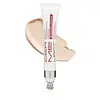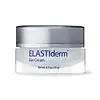What's inside
What's inside
 Key Ingredients
Key Ingredients

 Benefits
Benefits

 Concerns
Concerns

 Ingredients Side-by-side
Ingredients Side-by-side

Water
Skin ConditioningC12-15 Alkyl Benzoate
AntimicrobialHydrogenated Polyisobutene
EmollientGlycerin
HumectantAcrylates Copolymer
Pvp
Emulsion StabilisingSilica
AbrasiveCetyl Alcohol
EmollientGlyceryl Stearate
EmollientPEG-100 Stearate
PEG-40 Stearate
EmulsifyingDimethicone
EmollientHydrolyzed Sesame Protein Pg-Propyl Methylsilanediol
Skin ConditioningHydrolyzed Wheat Protein
Skin ConditioningSoy Protein Phthalate
EmollientPolyacrylamide
C13-14 Isoparaffin
EmollientLaureth-7
EmulsifyingSteareth-20
CleansingN-Hydroxysuccinimide
Skin ConditioningChrysin
Skin ConditioningPalmitoyl Tripeptide-1
Skin ConditioningPalmitoyl Tetrapeptide-7
Skin ConditioningButylene Glycol
HumectantAcetyl Tetrapeptide-5
HumectantPhenoxyethanol
PreservativeEthylhexylglycerin
Skin ConditioningCI 77891
Cosmetic ColorantCI 77491
Cosmetic ColorantWater, C12-15 Alkyl Benzoate, Hydrogenated Polyisobutene, Glycerin, Acrylates Copolymer, Pvp, Silica, Cetyl Alcohol, Glyceryl Stearate, PEG-100 Stearate, PEG-40 Stearate, Dimethicone, Hydrolyzed Sesame Protein Pg-Propyl Methylsilanediol, Hydrolyzed Wheat Protein, Soy Protein Phthalate, Polyacrylamide, C13-14 Isoparaffin, Laureth-7, Steareth-20, N-Hydroxysuccinimide, Chrysin, Palmitoyl Tripeptide-1, Palmitoyl Tetrapeptide-7, Butylene Glycol, Acetyl Tetrapeptide-5, Phenoxyethanol, Ethylhexylglycerin, CI 77891, CI 77491
Water
Skin ConditioningC12-15 Alkyl Benzoate
AntimicrobialEthylhexyl Palmitate
EmollientC13-15 Alkane
SolventCyclopentasiloxane
EmollientGlycerin
HumectantGlyceryl Stearate
EmollientPEG-100 Stearate
Propylene Glycol
HumectantStearyl Alcohol
EmollientDipropylene Glycol Dibenzoate
EmollientDimethicone
EmollientPPG-15 Stearyl Ether Benzoate
EmollientPolyacrylamide
Cetyl Alcohol
EmollientCetyl Dimethicone
EmollientC13-14 Isoparaffin
EmollientXanthan Gum
EmulsifyingMagnesium Aluminum Silicate
AbsorbentLaureth-7
EmulsifyingTocopheryl Acetate
AntioxidantGlycyrrhiza Glabra Root Extract
BleachingAlgae Extract
EmollientVaccinium Angustifolium Fruit Extract
Skin ProtectingPhenoxyethanol
PreservativeMethylparaben
PreservativeEthylparaben
PreservativeButylparaben
MaskingPropylparaben
PreservativeIsobutylparaben
AntimicrobialHdi/Trimethylol Hexyllactone Crosspolymer
Sodium Hydroxide
BufferingMalonic Acid
BufferingMalachite
Skin ConditioningZinc Carbonate
Silica
AbrasiveTalc
AbrasiveAlumina
AbrasiveMica
Cosmetic ColorantCI 77891
Cosmetic ColorantCI 77491
Cosmetic ColorantCI 42090
Cosmetic ColorantWater, C12-15 Alkyl Benzoate, Ethylhexyl Palmitate, C13-15 Alkane, Cyclopentasiloxane, Glycerin, Glyceryl Stearate, PEG-100 Stearate, Propylene Glycol, Stearyl Alcohol, Dipropylene Glycol Dibenzoate, Dimethicone, PPG-15 Stearyl Ether Benzoate, Polyacrylamide, Cetyl Alcohol, Cetyl Dimethicone, C13-14 Isoparaffin, Xanthan Gum, Magnesium Aluminum Silicate, Laureth-7, Tocopheryl Acetate, Glycyrrhiza Glabra Root Extract, Algae Extract, Vaccinium Angustifolium Fruit Extract, Phenoxyethanol, Methylparaben, Ethylparaben, Butylparaben, Propylparaben, Isobutylparaben, Hdi/Trimethylol Hexyllactone Crosspolymer, Sodium Hydroxide, Malonic Acid, Malachite, Zinc Carbonate, Silica, Talc, Alumina, Mica, CI 77891, CI 77491, CI 42090
Ingredients Explained
These ingredients are found in both products.
Ingredients higher up in an ingredient list are typically present in a larger amount.
C12-15 Alkyl Benzoate is made up of Benzoic Acid and long chain alcohols. It has a low molecular weight.
C12-15 Alkyl Benzoate is an emollient and texture enhancer. Due to its solubility, it is often used in sunscreens to help evenly distribute active ingredients.
As an emollient, C12-15 Alkyl Benzoate helps soften and hydrate your skin. Emollients create a film on your skin that traps moisture within.
This ingredient has been reported to cause eye irritation.
Learn more about C12-15 Alkyl BenzoateThis ingredient is also known as "C13-14 Isoalkane".
C13-14 Isoparaffin is created from petroleum-based mineral oils. It is an emollient and helps thicken a product.
As an emollient, it helps keep the skin soft and smooth by creating a barrier on top. This barrier traps moisture in, keeping the skin hydrated.
C13-14 Isoparaffin may not be fungal-acne safe.
Learn more about C13-14 IsoparaffinCetyl Alcohol is a fatty alcohol. Fatty Alcohols are most often used as an emollient or to thicken a product.
Its main roles are:
Though it has "alcohol" in the name, it is not related to denatured alcohol or ethyl alcohol.
The FDA allows products labeled "alcohol-free" to have fatty alcohols.
Learn more about Cetyl AlcoholCi 77491 is also hydrated iron III oxide. It's sole purpose is to give a red/pink hue to products.
Iron III oxides are classified as inorganic chemicals for coloring.
Synthetically created Ci 77491 is considered safer than those naturally found. This is because the synthetically created version may contain less impurities. Iron oxides are generally non-toxic and non-allergenic.
Learn more about CI 77491Ci 77891 is a white pigment from Titanium dioxide. It is naturally found in minerals such as rutile and ilmenite.
It's main function is to add a white color to cosmetics. It can also be mixed with other colors to create different shades.
Ci 77891 is commonly found in sunscreens due to its ability to block UV rays.
Learn more about CI 77891Dimethicone is a type of synthetic silicone created from natural materials such as quartz.
What it does:
Dimethicone comes in different viscosities:
Depending on the viscosity, dimethicone has different properties.
Ingredients lists don't always show which type is used, so we recommend reaching out to the brand if you have questions about the viscosity.
This ingredient is unlikely to cause irritation because it does not get absorbed into skin. However, people with silicone allergies should be careful about using this ingredient.
Note: Dimethicone may contribute to pilling. This is because it is not oil or water soluble, so pilling may occur when layered with products. When mixed with heavy oils in a formula, the outcome is also quite greasy.
Learn more about DimethiconeGlycerin is already naturally found in your skin. It helps moisturize and protect your skin.
A study from 2016 found glycerin to be more effective as a humectant than AHAs and hyaluronic acid.
As a humectant, it helps the skin stay hydrated by pulling moisture to your skin. The low molecular weight of glycerin allows it to pull moisture into the deeper layers of your skin.
Hydrated skin improves your skin barrier; Your skin barrier helps protect against irritants and bacteria.
Glycerin has also been found to have antimicrobial and antiviral properties. Due to these properties, glycerin is often used in wound and burn treatments.
In cosmetics, glycerin is usually derived from plants such as soybean or palm. However, it can also be sourced from animals, such as tallow or animal fat.
This ingredient is organic, colorless, odorless, and non-toxic.
Glycerin is the name for this ingredient in American English. British English uses Glycerol/Glycerine.
Learn more about GlycerinGlyceryl Stearate is a mix of glycerin and stearic acid.
It is used to stabilize the mixing of water and oil ingredients. By preventing these ingredients from separating, it can help elongate shelf life. It can also help thicken the product's texture.
As an emollient, it helps soften skin and supports barrier-replenishing ingredients.
In cosmetics, Glyceryl Stearate is often made from vegetable oils or synthetically produced.
This ingredient may not be fungal-acne safe
Fun fact: The human body also creates Glyceryl Stearate naturally.
Learn more about Glyceryl StearateLaureth-7 is created by the ethoxylation of lauryl alcohol using ethylene oxide. Lauryl alcohol is a fatty alcohol with hydrating properties.
This ingredient is an emulsifier and cleansing ingredient. As an emulsifier, it is used to prevent ingredients from separating. It also helps cleanse the skin by gathering dirt, oil, and pollutants to be rinsed away.
Peg-100 Stearate is an emollient and emulsifier. As an emollient, it helps keep skin soft by trapping moisture in. On the other hand, emulsifiers help prevent oil and water from separating in a product.
PEGS are a hydrophilic polyether compound . There are 100 ethylene oxide monomers in Peg-100 Stearate. Peg-100 Stearate is polyethylene glycol ester of stearic acid.
Phenoxyethanol is a preservative that has germicide, antimicrobial, and aromatic properties. Studies show that phenoxyethanol can prevent microbial growth. By itself, it has a scent that is similar to that of a rose.
It's often used in formulations along with Caprylyl Glycol to preserve the shelf life of products.
Polyacrylamide is a synthetic polymer. It is used to stabilize products and bind ingredients. When hydrated, Polyacrylamide forms a soft gel.
Polyacrylamide is low-toxicity. If source properly, it is deemed safe to use in cosmetics.
It should be noted the precursor to Polyacrylamide is acrylamide. Acrylamide is a carcinogen. Most reputable sources of Polyacrylamide will screen for residual acrylamide to make sure the count is in a safe range. Acrylamide is not able to be absorbed through the skin.
We recommend speaking with a professional if you have concerns.
Learn more about PolyacrylamideSilica, also known as silicon dioxide, is a naturally occurring mineral. It is used as a fine, spherical, and porous powder in cosmetics.
Though it has exfoliant properties, the function of silica varies depending on the product.
The unique structure of silica enhances the spreadability and adds smoothness, making it a great texture enhancer.
It is also used as an active carrier, emulsifier, and mattifier due to its ability to absorb excess oil.
In some products, tiny microneedles called spicules are made from silica or hydrolyzed sponge. When you rub them in, they lightly polish away dead skin layers and enhance the penetration of active ingredients.
Learn more about SilicaWater. It's the most common cosmetic ingredient of all. You'll usually see it at the top of ingredient lists, meaning that it makes up the largest part of the product.
So why is it so popular? Water most often acts as a solvent - this means that it helps dissolve other ingredients into the formulation.
You'll also recognize water as that liquid we all need to stay alive. If you see this, drink a glass of water. Stay hydrated!
Learn more about Water